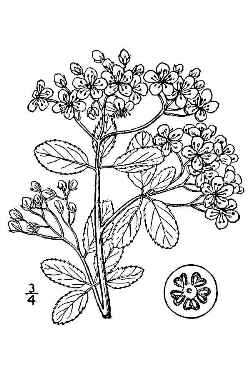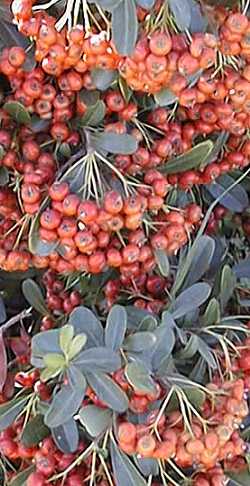Fire Thorn
Scientific Name: Pyracantha coccinea M. Roem.
Synonym: Cotoneaster pyracantha
Family: Rosaceae
Sunset®: 2-24,26,28-41
USDA: 8-10
Heat Tolerance: Avoid reflected heat from a south or west wall in Phoenix
Sun Exposure: Full sun
Origin: China
Growth Habits: Evergreen shrub or vine, up to 10 feet tall (3 m); thorny stems; finely toothed leaves, up to 1.6 inches long (4 cm)
Flowers: White flowers
Watering Needs: Moderate water
Propagation: Seeds, semi hardwood cuttings in summer to late summer.
Propagation: Cutting
- by semi-hardwood secondary cuttings, in spring. Use intermittent mist. Root in 10 weeks.

Britton, N.L., and A. Brown. 1913. Illustrated flora of the northern states and Canada. Vol. 2: 322.
Firethorns are very attractive bushes that can be trimmed in basically any shape you want. They are attractive as barriers or espaliered against a wall. The bushes are covered of red berries in the fall. The berries are not poisonous (or at least I wasn't getting sick eating them regularly as a kid).
Culture:
As many bushes from the rose family, Fire thorns are sensitive to fire blight. Shoots die, leaves wither. Cut below the infected branch, and disinfect your tools in chlorine. The disease can kill the bush fairly rapidly.
Propagation:
The seeds of the firethorn can be collected in summer. Stratify them for 3 months at 40°F (4°C). It is possible to graft Pyracantha on Cotoneaster.
Desert-Tropicals is dedicated to provide gardening advice, gardening ideas, and information about flower of all kind for landscape and collections.We try to check carefully the identification of the plants on the illustrations as well as the other information from the page, but occasionally errors do occur. if you notice anything that needs to be changed please contact us.Thanks.
© 1998-2020 Philippe Faucon, All Rights Reserved.
